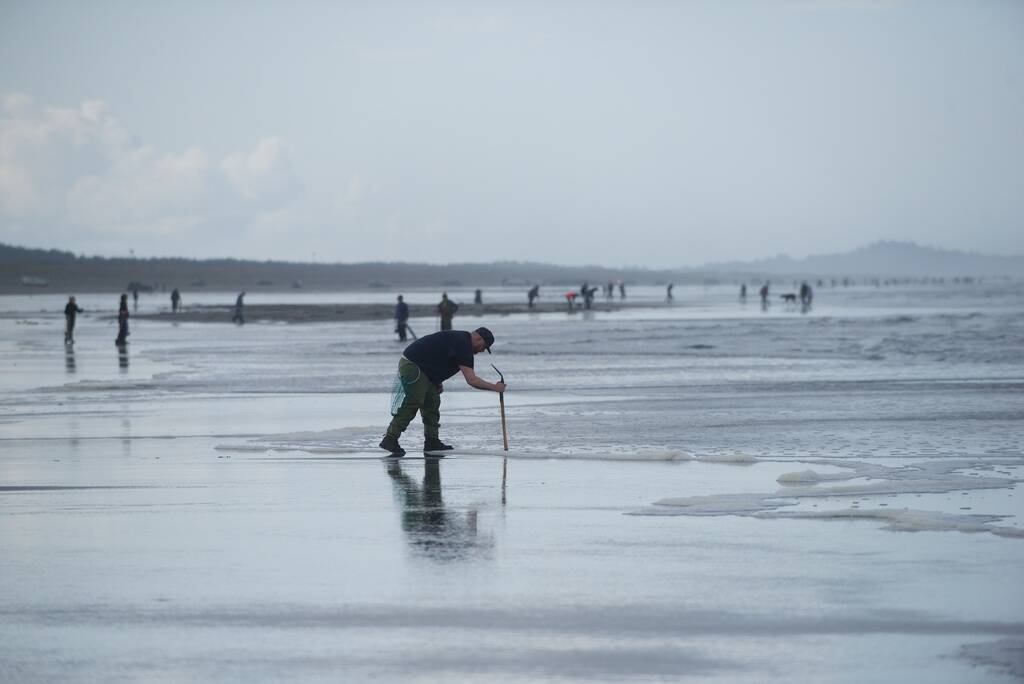The final round of razor clam digs should be a doozy in late April and early May with countless plus-size mollusks awaiting beachgoers on the shores of Grays Harbor County and Pacific County.
Shellfish managers with the Washington Department of Fish and Wildlife said on Friday, April 22, that the next round of digging will take place as planned from April 29 through May 7. And much like the most recent dig, the daily limit will be 20 clams.
“As we enter the homestretch of the 2021-22 recreational razor clam season, it’s quite clear that this will go down as one of the best on record,” said Dan Ayres, coastal shellfish manager for the Department of Fish and Wildlife, in a statement.
“Looking to the future, the cooler productive ocean conditions we are experiencing now may be a good indicator for another great season starting this fall.”
A total of 432,380 diggers have taken part in the 2021-22 razor clam digging season from Sept. 17, 2021 through April 21 for a total of 111 digging days heading into the final stretch. Those diggers have taken home more than 7.1 million mollusks, the Department of Fish and Wildlife said.
During the most recent digs — April 16-21 — the average haul was 19.1 clams per person in Long Beach; 19.3 clams per person at Twin Harbors; 19.2 clams per person at Copalis; and 18.7 clams per person at Mocrocks.
Diggers are reminded that their clams must be kept in a separate container, and they must keep the first 20 clams they dig regardless of condition or size.
The following digs during mid- to late-morning hours and low tides will proceed after marine toxin results from the Washington Department of Health showed that razor clams are safe to eat. Digging is allowed during low tide from 12 a.m. through 11:59 a.m. only.
— Friday, April 29, 6:31 a.m.; -0.1 feet; Long Beach, Twin Harbors and Copalis.
— Saturday, April 30, 7:10 a.m.; -0.5 feet; Long Beach, Twin Harbors and Mocrocks.
— Sunday, May 1, 7:47 a.m.; -0.8 feet; Long Beach, Twin Harbors and Copalis.
— Monday, May 2, 8:22 a.m.; -0.8 feet; Long Beach, Twin Harbors and Mocrocks.
— Tuesday, May 3, 8:57 a.m.; -0.7 feet; Long Beach, Twin Harbors and Copalis.
— Wednesday, May 4, 9:34 a.m.; -0.4 feet; Long Beach, Twin Harbors and Mocrocks.
— Thursday, May 5, 10:13 a.m.; -0.1 feet; Long Beach, Twin Harbors and Copalis.
— Friday, May 6, 10:57 a.m.; +0.2 feet; Long Beach, Twin Harbors and Mocrocks.
— Saturday, May 7, 11:48 a.m.; +0.5 feet; Long Beach, Twin Harbors and Copalis. The digging hours have been extended to 1 p.m. for the May 7 dig only.
“Not all beaches are open for every dig, so diggers are encouraged to make sure their intended destination is open before heading out,” the Department of Fish and Wildlife said in a statement. “The most successful digging occurs between one and two hours before the listed time of low tide.”
The size of razor clams seen in surveys are hefty. At Long Beach the average is 4.3”; Twin Harbors, 4.7”; Copalis, 4.8”; and Mocrocks, 4.5”.
The upcoming round of razor clam digs also drew some words of advice and caution.
“As in past years, WDFW is asking beachgoers to avoid disturbing nesting snowy plovers — an endangered shorebird — by staying out of the dunes and posted areas along the Southwest Washington coast,” the Department of Fish and Wildlife said in a statement.
“Snowy plover nests are nearly invisible, and it is vital to give these birds the space they need to live and thrive during their nesting period, especially along the southern end on Twin Harbors — known as Midway Beach — and the north end of Long Beach.”
Razor clam diggers must have a new 2022-23 recreational fishing or shellfishing license to participate in the digs.
To learn more about razor clam abundance, population densities at various beaches, and how seasons are set, visit wdfw.wa.gov/fishing/shellfishing-regulations/razor-clams#management.


